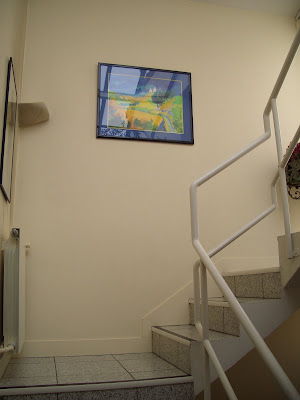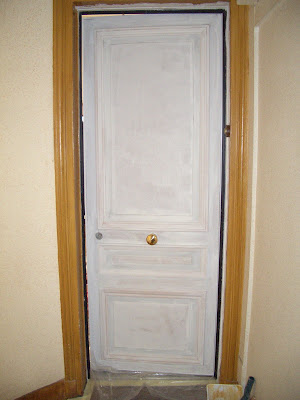www .ateliersdemenilmontant.org
I’m showing my work this weekend (26-29 September) in the open studio festival in Ménilmontant. There are about 140 artists showing in the neighborhood. The public can walk around visiting studio spaces, showrooms, apartments and cafés. My friends Christophe and Marie are lending me their living room. Isn’t that nice!
For the last month I’ve been working on two painting themes. The first series I started is inspired by the book, ”An Iliad” by Alessandro Baricco, a modern translation of the Homeric poem told from the viewpoint of individuals and in which references to the gods have been removed.
Sorry, I’ve probably made it sound horrible to purists but the story flowed without the intervention of the gods (although sometimes not quite logically), was very exiting (and terribly gory) and not at all intimidating (much, much, much shorter). I read the French translation and was impressed by certain texts, enough to think about making paintings to illustrate or compliment these quotes. But illustration isn’t the right word. I thought about visual correlations.
Like for Thersites, the ugliest man in the Trojan War. I had my eye on a small, sad pine tree at the Buttes Chaumont Park. It was poignantly pathetic and I had wanted to paint it for a long time. So it became my metaphor for the bow-legged, lame Thersites.

Then I started thinking about Helen of Troy and how to represent her. I have this lovely embroidered bodice with beads, sequins and even light bulbs (alas, they don’t light up). It’s beautiful and it was nice to paint it as the incarnation of Helen, the most incommensurably beautiful woman.

As for Pâris and Hector, I had passed a fountain at the Luxembourg gardens near the Observatory and took photos of it. It’s very baroque and as the horses preen with arrogance, I thought that human vanity was well symbolized.

The last painting in the series for the moment is inspired by Achilles refusal to join in the battle, basically saying that accumulating riches isn’t worth life, which can’t be bought or stolen. He talks about cows and fat sheep. I had painted sheep in a field except that I never did paint the field. I just left the ground (bare linen canvas) untouched for months. Friends would ask if the painting was finished but I wasn’t sure. Some thought I should leave it but after much thought, I decided that sheep can represent the riches in life but mine were more like clouds in heaven, so I suggested a sky.


I’ll be moving my work to Ménilmontant tomorrow and will write about the other theme I’ve been working on, a Massacre, real soon.
www.ateliersdemenilmontant.orgJe participe ce weekend (du 26 au 29 septembre) aux portes ouvertes à Ménilmontant. Nous sommes 140 artistes exposants nos œuvres dans le quartier. Le public peut visiter les ateliers, les showrooms, les appartements et les cafés. C’est mes amis Christophe et Marie qui m’ont prêté leur appartement.J’ai travaillé deux thèmes de peinture ce dernier mois. Le premier thème à été inspiré du livre ‘l’Iliade’ d’Alessandro Baricco qui a écrit une traduction moderne de l’épique de Homère racontée par les acteurs sans l’intervention ni la référence des dieux.C’est très excitant, très gore et pas du tout intimidant (bien plus court et pas en vers). Je l’ai lu en français et j’étais très touchée par certains passages. Par d’autres, j’étais assez stimulée pour chercher des corrélations visuelles. (Je ne voulais pas les illustrer quand même.)Comme pour Thersites, l’homme le plus laid de la guerre de Troie, j’avais ma métaphore ; un petit sapin triste et pathétique aux Buttes Chaumont. Cela fait longtemps que j’ai envie de le peindre. Puis j’ai pensé à Hélène et sa représentation. J’ai choisi un très beau corsage brodé de perles, de sequins et même de petites ampoules l’incarnation d’Hélène la plus belle des mortelles.J’ai pris des photos de la fontaine des jardins du Luxembourg près de l’Observatoire. Une fontaine d’où sortent de magnifiques chevaux baroques, pleins de fierté et d’arrogance. Je trouvais que la vanité humaine était bien représentée.Le dernier tableau de cette séquence représente Achilles refusant de se battre. Il dit « On peut voler des bœufs, et de grasses brebis, on peut accumuler des chevaux et les trépieds précieux, en les achetant à prix d’or : mais la vie, tu ne peux pas la subtiliser, tu ne peux pas l’acheter. » J’aime cette citation. J’avais déjà peint un pré de moutons sans faire le pré. Je l’ai laissé nu. J’hésitais, je trouvais que la toile n’était pas finie mais un pré vert sera trop bête. Puis j’ai pensé que les moutons sont comme des nuages, éphémères, donc je les ai mis dans un ciel.Je déménage mes toiles à Ménilmontant demain. Le prochain billet sera sur l’autre thème, ‘Un Massacre’.























































